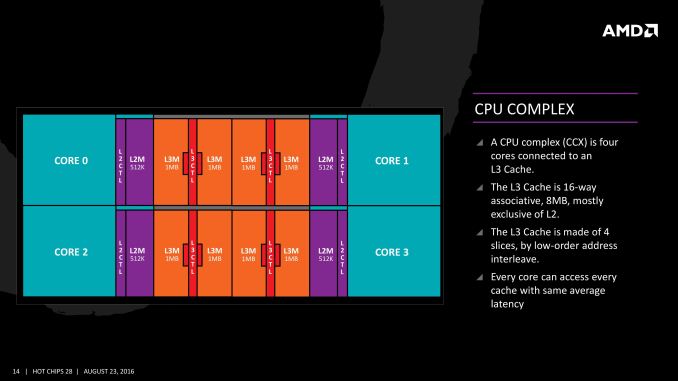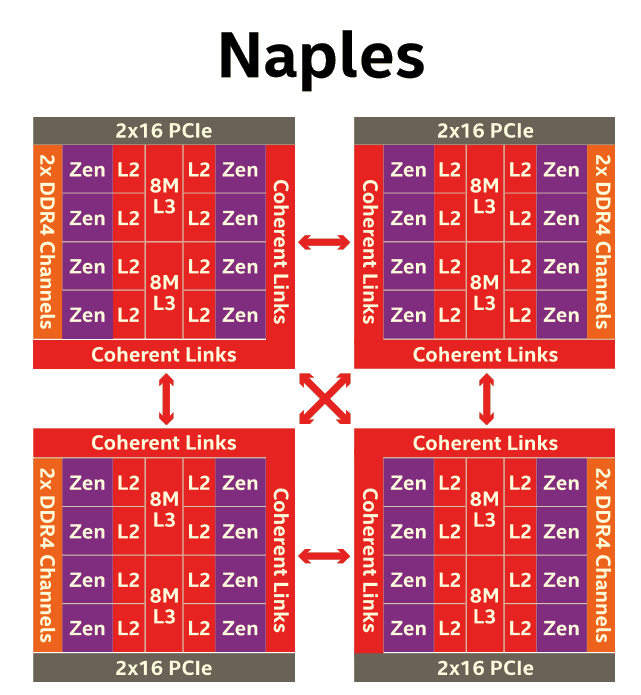Sizing Up Servers: Intel's Skylake-SP Xeon versus AMD's EPYC 7000 - The Server CPU Battle of the Decade?
by Johan De Gelas & Ian Cutress on July 11, 2017 12:15 PM EST- Posted in
- CPUs
- AMD
- Intel
- Xeon
- Enterprise
- Skylake
- Zen
- Naples
- Skylake-SP
- EPYC
AMD's EPYC Server CPU
If you have read Ian's articles about Zen and EPYC in detail, you can skip this page. For those of you who need a refresher, let us quickly review what AMD is offering.
The basic building block of EPYC and Ryzen is the CPU Complex (CCX), which consists of 4 vastly improved "Zen" cores, connected to an L3-cache. In a full configuration each core technically has its own 2 MB of L3, but access to the other 6 MB is rather speedy. Within a CCX we measured 13 ns to access the first 2 MB, and 15 to 19 ns for the rest of the 8 MB L3-cache, a difference that's hardly noticeable in the grand scheme of things. The L3-cache acts as a mostly exclusive victim cache.
Two CCXes make up one Zeppelin die. A custom fabric – AMD's Infinity Fabric – ties together two CCXes, the two 8 MB L3-caches, 2 DDR4-channels, and the integrated PCIe lanes. That topology is not without some drawbacks though: it means that there are two separate 8 MB L3 caches instead of one single 16 MB LLC. This has all kinds of consequences. For example the prefetchers of each core make sure that data of the L3 is brought into the L1 when it is needed. Meanwhile each CCX has its own separate (not inside the L3, so no capacity hit) and dedicated SRAM snoop directory (keeping track of 7 possible states). In other words, the local L3-cache communicates very quickly with everything inside the same CCX, but every data exchange between two CCXes comes with a tangible latency penalty.
Moving further up the chain, the complete EPYC chip is a Multi Chip Module(MCM) containing 4 Zeppelin dies.
AMD made sure that each die is only one hop apart from the other, ensuring that the off-die latency is as low as reasonably possible.
Meanwhile scaling things up to their logical conclusion, we have 2P configurations. A dual socket EPYC setup is in fact a "virtual octal socket" NUMA system.
AMD gave this "virtual octal socket" topology ample bandwidth to communicate. The two physical sockets are connected by four bidirectional interconnects, each consisting of 16 PCIe lanes. Each of these interconnect links operates at +/- 38 GB/s (or 19 GB/s in each direction).
So basically, AMD's topology is ideal for applications with many independently working threads such as small VMs, HPC applications, and so on. It is less suited for applications that require a lot of data synchronization such as transactional databases. In the latter case, the extra latency of exchanging data between dies and even CCX is going to have an impact relative to a traditional monolithic design.













219 Comments
View All Comments
oldlaptop - Thursday, July 13, 2017 - link
Why on earth is gcc -Ofast being used to mimic "real-world", non-"aggressively optimized"(!) conditions? This is in fact the *most* aggressive optimization setting available; it is very sensitive to the exact program being compiled at best, and generates bloated (low priority on code size) and/or buggy code at worst (possibly even harming performance if the generated code is so big as to harm cache coherency). Most real-world software will be built with -O2 or possibly -Os. I can't help but wonder why questions weren't asked when SPEC complained about this unwisely aggressive optimization setting...peevee - Thursday, July 13, 2017 - link
"added a second full-blown 512 bit AVX-512 unit. "Do you mean "added second 256 ALU, which in combination with the first one implements full 512-bit AVX-512 unit"?
peevee - Thursday, July 13, 2017 - link
"getting data from the right top node to the bottom left node – should demand around 13 cycles. And before you get too concerned with that number, keep in mind that it compares very favorably with any off die communication that has to happen between different dies in (AMD's) Multi Chip Module (MCM), with the Skylake-SP's latency being around one-tenth of EPYC's."1/10th? Asking data from L3 on the chip next to it will take 130 (or even 65 if they are talking about averages) cycles? Does not sound realistic, you can request data from RAM at similar latencies already.
AmericasCup - Friday, July 14, 2017 - link
'For enterprises with a small infrastructure crew and server hardware on premise, spending time on hardware tuning is not an option most of the time.'Conversely, our small crew shop has been tuning AMD (selected for scalar floating point operations performance) for years. The experience and familiarity makes switching less attractive.
Also, you did all this in one week for AMD and two weeks for Intel? Did you ever sleep? KUDOS!
JohanAnandtech - Friday, July 21, 2017 - link
Thanks for appreciating the effort. Luckily, I got some help from Ian on Tuesday. :-)AntonErtl - Friday, July 14, 2017 - link
According to http://www.anandtech.com/show/10158/the-intel-xeon... if you execute just one AVX256 instruction on one core, this slows down the clocks of all E5v4 cores on the same socket for at least 1ms. Somewhere I read that newer Xeons only slow down the core that executes the AVX256 instruction. I expect that it works the same way for AVX512, and yes, this means that if you don't have a load with a heavy proportion of SIMD instructions, you are better off with AVX128 or SSE. The AMD variant of having only 128-bit FPUs and no clock slowdown looks better balanced to me. It might not win Linpack benchmark competitions, but for that one uses GPUs anyway these days.wagoo - Sunday, July 16, 2017 - link
Typo on the CLOSING THOUGHTS page: "dual Silver Xeon solutions" (dual socket)Great read though, thanks! Can finally replace my dual socket shanghai opteron home server soon :)
Chaser - Sunday, July 16, 2017 - link
AMD's CPU future is looking very promising!bongey - Tuesday, July 18, 2017 - link
EPYC power consumption is just wrong. Somehow you are 50W over what everyone else is getting at idle. https://www.servethehome.com/amd-epyc-7601-dual-so...Nenad - Thursday, July 20, 2017 - link
Interesting SPECint2006 results:- Intel in their slide #9 claims that Intel 8160 is 2% faster than EPYC 7601
- Anandtech in article tests that EPYC 7601 is 42% faster than Intel 8176
Those two are quite different, even if we ignore that 8176 should be faster than 8160. In other words, those Intel test results look very suspicious.